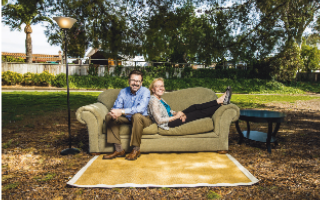Whether doing it yourself or hiring a professional, staging can boost a listings chances of being sold more quickly in any kind of market.
By Regina Ludes
The purpose of staging is to engage the heart of prospective buyers to move them toward a sale, says Carl Medford, CRS, with Keller Williams Realty in Fremont, California. We get them there much quicker with a staged home than a vacant one.
According to the National Association of REALTORS® 2015 Profile of Home Staging, 81 percent of REALTORS® say staging makes it easier for buyers to visualize a property as a future home, and 46 percent say buyers are more willing to walk through a home that they viewed online.
The practice of staging de-cluttering, cleaning and accessorizing a home before putting it on the market has gained greater public awareness in the past 10 years, thanks to home improvement programs on HGTV. But better-educated consumers mean higher expectations, and todays buyers want to purchase a home that is move-in ready with no additional effort on their part. REALTORS® who offer staging consultations or services say staging helps sellers fix the flaws in the home and update the décor to current standards to make the home appear more move-in ready. Those efforts can pay off by achieving a quicker sale for close to the list price, leading to a win-win-win situation for the agent, buyer and seller.
The Marketing Advantage
The practice of staging has been around at least since the 1960s, but most people did not know about it then, says Shell Brodnax, CEO of the Real Estate Staging Association. It has only become more mainstream in real estate since the early 2000s when the housing boom and subsequent downturn created a more competitive real estate marketplace and agents turned to staging to help them sell their listings.
Initially, stagers and agents used lower-end furniture and accessories, but now they use the best pieces available, says Brodnax. Staging is all about marketing and merchandising, just like for any other product. The home is competing with others on the market, so you want to present it perfectly like a model home with all the correct pieces of furniture and accent pieces positioned in the correct places, Brodnax says.
A stager will offer different levels of services depending on the clients needs. The average homeowners might require only a consultation in which the stager will tell them what they need to do and whether they want to do the work themselves or hire the stager to do it for them, says Brodnax. For vacant properties, staging is necessary because it is rare for someone to walk into a vacant home and see its possibilities.
The costs of staging can typically run between $1,800 and $5,000, depending on how much work needs to be done, the size of the home and how many rooms are staged, says Brodnax. Most stagers will work within the sellers budget and advise them how best to invest their dollars when preparing their home for sale, she says.
More Info
What a Difference a Stage Makes
Accessorizing a home enables homebuyers to more easily visualize the possibilities compared to a home that has not been staged.
How much staging is required depends on the price point of the listing, says Kelly Cobb, CRS, with Fonville Morisey, a Long and Foster Company, in Cary, North Carolina. For her listings, staging is more important for homes listed at $300,000 or higher because her market is more competitive at that price point. Buyers dont want to purchase a project. They want a home that is move-in ready, says Cobb.
Though she earned the ASP designation for stagers, Cobb offers all her clients a two-hour consultation at her own expense with another professional stager. There are some things that a stager can discuss with my clients that I cant bring up because it might be uncomfortable, she explains. In those two hours, the client and stager work out a plan about what needs to be done to prepare the home for the market.
When clients are trying to decide whether to spend money on freshening up their homes appearance, Cobb explains to them that the cost is usually much less than the first reduction in price if the home were to sit on the market. Spending money upfront will net less time on the market, which in our area, translates into a higher net price, she says.
For all its advantages, some sellers still need convincing to have their home staged. Showing before and after photos can present a compelling case for staging, Cobb says. You can also invite them to view other listings online to see what competing properties look like. When they see that their home looks dated and old, its an easier sell.
Setting the Stage
When we begin working with a client, I tell them it is just like watching HGTV, says Medford, who attributes the growing awareness and demand for staging to programs on the popular cable network.
Medford and his wife have their own staging company called The Next Stage and a warehouse filled with furniture and accessories. He also teaches other agents in his area about staging techniques, and many of these agents turn to Medford for staging services. We teach three basic things: the psychology of staging, overcoming objections and how to stage the property. Most agents quickly figure out that they need to leave staging to the professionals because there is an art to decorating a vacant room, he says. The majority of buyers today dont have a clue about how to decorate a room, and they have no sense of scale or perspective. To walk into a room and see it arranged in an attractive way resonates with buyers, Medford says.
Cost can be an issue for some sellers who dont want to spend the money or cant afford it. For this reason, Medford does not stage short sales because money is often an issue with the owner.
For critics and skeptics who say staging is contrived, Medford responds, All advertising is contrived. Staging is about maximizing a propertys potential. Yes, that might be manipulation and influencing, but its about marketing the home. Youll never see an unstaged model home from a builder.
{loadposition agents_staging}
{loadposition staging_homevalue}
Double Feature
Whenever a client or colleague expresses skepticism about staging, Risé Johns, CRS, with Keller Williams Realty in Lago Vista, Texas, outside Austin, shares a couple of examples of how two of her listings sold more quickly after staging. In one instance, a property languished on the market for nearly a year because buyers were confused by the unusual layout of the lower level of the home. The feedback we got from people was that they could not see how the lower level was to be used, Johns recalls. The space contained a tiny kitchenette and three rooms: one with no windows that was used as an office, a second area with a tiled floor that was vacant and a third room adjacent to it that was carpeted and used as a craft room.
Her stager, Susan Honning with Texas Staged Homes, converted the two adjacent spaces into one combo recreation area with a TV room and a game room with a table, chairs and a chess set. She also added a wine rack and glassware in the kitchenette, turning it into a wine bar. The overall presentation appealed to younger buyers, and the home sold in 45 days, far less than the 142 days average time on the market in her area.
The second example involved the sale of a friends home, which also had been on the market for a year. I had suggested staging his home on several previous occasions, and he always said no, Johns recalls. This time, she invited him to visit the home with the unusual layout so he could see the effects of staging. After viewing it, he agreed to have his home staged. In the year my friends home had been on the market, a young couple had come twice to see it, but walked away because they could not see themselves living in it, recalls Johns. After it was staged, she invited them to see it again. This time, the couple spent an hour walking through the house, admiring the way the rooms were decorated, Johns says. The couple put a bid on the house shortly thereafter and closed on it quickly.
Johns says staging has the biggest impact on bedrooms. Buyers believe bedrooms are too small for their needs and that the bed is actually bigger than it really is. But a bedroom with basic furniture appears larger than a vacant room, she says.
Most sellers are reluctant to spend money on staging. But when they see how other homes appear after staging and how quickly those homes sell on the market, they are willing to try it, Johns says.
While concerns about costs and effectiveness remain, staging has proven to be a worthwhile practice that is here to stay.
Learn more from NARs 2015 Profile of Home Staging at REALTOR.org.








